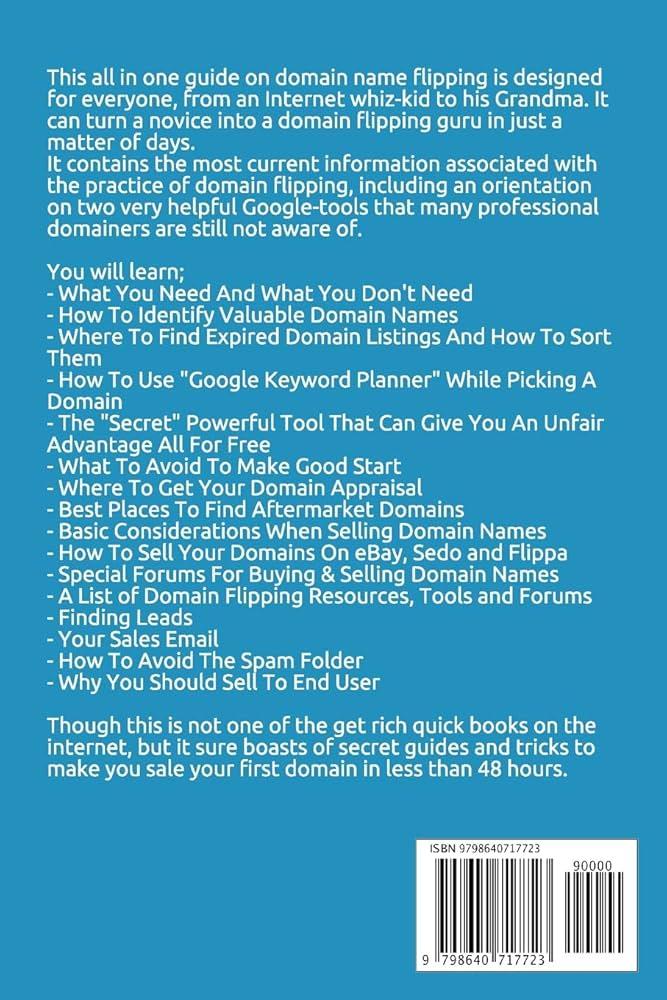Table of Contents
- Exploring the Profit Potential of Email Domain Flipping
- Identifying Valuable Email Domains for Successful Flipping
- Effective Strategies for Buying and Selling Email Domains
- Navigating Legal Considerations in Domain Flipping
- Maximizing Your Return on Investment in Email Domain Sales
- Q&A
- Wrapping Up


Exploring the Profit Potential of Email Domain Flipping
With the increasing reliance on digital communication, email domains are becoming a sought-after commodity. Investing in email domain flipping can yield substantial profits, especially for those who understand the nuances of this niche market. A strong domain can enhance a brand’s credibility and recognition, driving demand from businesses looking to strengthen their online presence.
There are several key factors to consider when delving into this profitable venture:
- Market Trends: Keeping an eye on emerging trends can provide insights into which domains are likely to appreciate in value.
- Domain Length: Short, catchy domains tend to have higher resale values, as they are easier to remember and type.
- Keyword Value: Domains that include popular keywords can attract buyers looking to optimize their search rankings.
To maximize potential profits, it’s essential to analyze comparable sales and pricing strategies. Here’s a quick reference table highlighting some average selling prices for various types of email domains:
| Domain Type | Average Selling Price |
|---|---|
| Single-Word Domains | $1,000 – $10,000+ |
| Brandable Domains | $500 – $5,000 |
| Keyword Domains | $100 – $3,000 |
By carefully assessing the market and understanding the value drivers of email domains, investors can strategically flip domains for a profit. Engaging with the right audience, such as startups and established businesses looking to enhance their email identity, can further increase the chances of successfully selling domains at a premium price.
Identifying Valuable Email Domains for Successful Flipping
When it comes to flipping email domains for profit, the first step is identifying domains that hold intrinsic value. A valuable domain often encapsulates trends, brands, or keywords that people readily recognize. Look for domains that are short, memorable, and ideally possess some level of keyword relevance. Domains with generic, high-demand words such as “sale”, “shop”, or “news” can easily draw attention. Additional factors to consider include the presence of numbers, hyphens, or other characters, as these can diminish value unless they have a strong association with a brand or industry.
Another critical factor in assessing domain value is checking the domain history. A domain that has been previously owned may carry SEO juice if it was used for a website that garnered traffic and backlinks. Use tools like the Wayback Machine to view past snapshots of the domain and insights into its previous usage. Also, consider utilizing WHOIS lookups to check how long the domain has been registered, as those that are older may command premium prices due to their established history.
Additionally, market trends heavily influence the demand for specific domains. Pay attention to emerging industries and technologies, which often lead to increased interest in related keywords. For instance, with the rise of telehealth and remote work, domains featuring terms like “virtual”, “health”, or “remote” could become hot commodities. Creating a list of potential domains based on these trends can set you on the path to successful flipping:
- virtualhealthcare.com
- remoteworkhub.com
- dronedeliveryservice.com
Ultimately, the right combination of keyword relevance, history, and market trend awareness will drive success in email domain flipping.


Effective Strategies for Buying and Selling Email Domains
When diving into the world of email domain flipping, understanding the nuances of both buying and selling domains is crucial for success. Start with thorough market research to identify valuable keywords and domain trends. Websites such as NameBio and GoDaddy Auctions can provide insights into recent sales, helping to gauge what makes a domain appealing. Pay attention to the length of the domain, the inclusion of keywords, and the overall market demand to ensure you invest wisely.
Once you’ve pinpointed potential domains for purchase, consider the registration process. Utilize reputable registrars with clear policies and customer support options. When performing your due diligence, look for domains with a clean history—avoid those that might have been previously banned or associated with spam. It’s often beneficial to seek expired domains with existing backlinks, as they can provide immediate authority, boosting your chances of a successful resale.
On the selling side, crafting an enticing listing is pivotal. Highlight the benefits of the domain rather than just its features. Here are some effective strategies to consider:
- Utilize compelling language to convey value.
- Set a realistic price based on comparable sales.
- Promote across various platforms, including social media and niche forums.
Moreover, employing effective negotiation tactics can facilitate smoother transactions. Don’t shy away from discussing potential buyers’ needs, and be open to feedback. A transparent dialogue can foster trust and increase the likelihood of reaching an agreement. Remember, patience is key—finding the right buyer is often a drawn-out process!


Navigating Legal Considerations in Domain Flipping
When delving into the world of domain flipping, particularly with email domains, understanding the legal landscape is crucial. An essential step is ensuring that the domain you intend to flip does not infringe on existing trademarks. Conducting thorough research into the trademark status of name choices can prevent future lawsuits and protect your investment. Regularly check resources like the United States Patent and Trademark Office (USPTO) for potential conflicts that could jeopardize your domain’s value.
Another critical consideration is compliance with the Uniform Domain-Name Dispute-Resolution Policy (UDRP). Familiarizing yourself with this policy can help you avoid disputes arising from domain names that might be viewed as cybersquatting—buying domains to sell them at inflated prices, particularly those resembling established brands or trademarks. The UDRP outlines the legal recourse for trademark holders, and a violation can lead to losing your domain. To safeguard your interests, focus on acquiring domains that are not only marketable but also ethically defensible.
Furthermore, it’s beneficial to familiarize yourself with local laws governing domain flipping. Different jurisdictions may impose varying restrictions or requirements that could impact your sales strategy. Here are some key areas to review:
- Transfer laws: Understand how domain ownership transfer works to ensure smooth transactions.
- Tax implications: Be aware of how profits from domain flipping are taxed in your region.
- Privacy regulations: Know how to manage personal data when transaction details are involved.
By proactively addressing these aspects, you’ll not only protect your investments but also foster a robust business model for flipping email domains.


Maximizing Your Return on Investment in Email Domain Sales
To truly thrive in the lucrative world of email domain flipping, it’s crucial to understand the potential of your investment. Start by assessing your acquired domains for factors that increase their market value. Focus on short, memorable names that resonate with potential buyers. Consider using keyword-rich domains that align with popular industries or emerging trends, as these tend to have higher demand. Additionally, maintaining a well-curated portfolio of domains can enhance your credibility and leverage in negotiations. Don’t forget to keep an eye on renewal costs to ensure your investments remain profitable.
Leverage data and analytics to refine your sales strategies. Utilize tools that track email domain sales trends and market fluctuations, allowing you to identify when to buy or sell. SWOT analysis (Strengths, Weaknesses, Opportunities, Threats) can be particularly effective in evaluating your domains and formulating strategic actions. Supplement this by building a list of potential buyers and learning their preferences by analyzing similar transactions. This approach will provide you with invaluable insights for pitching and positioning your domains to maximize returns.
effective marketing of your email domains is key to attracting potential buyers. Craft compelling listings that clearly articulate the value proposition of each domain. Use persuasive storytelling, highlighting how your domains can advance a buyer’s brand or enhance their online presence. Consider showcasing successful use cases and buyer testimonials, and use channels like social media, email campaigns, and online marketplaces to maximize exposure. Delivering consistent, high-quality engagement will increase interest and drive competitive bidding on your domains.

